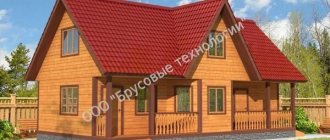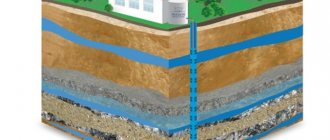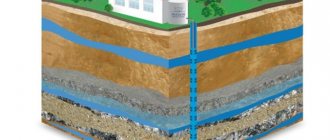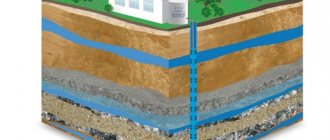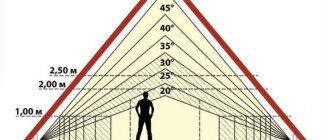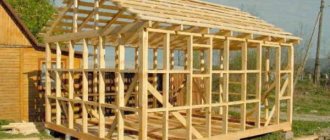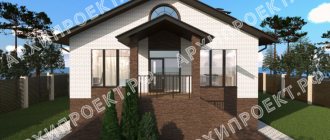In the West, a new trend is gradually gaining momentum - the construction of multi-storey buildings and various business centers from wood using frame technology. There are many new technologies in development for the construction of skyscrapers. Architects compete to build the tallest building made of wood. What are the real prospects for this area and should we expect that inexpensive and prefabricated housing will soon appear in Russia?
What type of foundation should I choose for a private house?
Laying the foundation is the most important process in any construction, be it a skyscraper or a private house. Each owner must choose the type of construction for his future home, regardless of whether he will carry out the construction himself or whether professional workers will do it. In the second case, you will receive recommendations from the experts, but it won’t hurt to figure out for yourself what types of house foundations are used today. In this article we will analyze each design in detail, and also find out in what cases it is used.
What is it and what is it for?
A foundation is a load-bearing element (support) of any structure that absorbs loads and distributes them along the base, located partially or completely underground.
It consists of a cut (upper part) and a sole (lower part) . The distance between them is the height of the foundation, and the distance between the base and the surface of the earth is usually called the depth of foundation or burial.
In essence, the foundation is the connecting link between the walls of the building and the ground. Its task is to perceive the full weight of the structure and operational loads, ensuring the stability of the structure under any changes in the soil and natural influences.
It must prevent subsidence, deformation, cracking and tilting of the walls under any loads throughout the entire life of the building.
The reliability, safety and service life of the entire structure depend on the strength and durability of the foundation. So what types of foundations are there?
Types of foundation.
Types of foundations for a private house.
The diagram shows the main types of structures for a private house.
For structures made of wood, foam blocks or concrete, the following types of foundation are used:
It is impossible to single out the best or worst option, since the design of each type of foundation for private houses is different. Accordingly, the construction costs will also be different.
Advice: to choose a suitable foundation, you need to take into account the climate, base material and soil characteristics. In any case, consultation with professional builders will not be superfluous.
Now let’s look at each type for a wooden and concrete private house, as well as structures made of foam blocks.
Construction technology of multi-storey buildings
The construction of a multi-storey residential building today is the main option for solving the housing problem for many developers. The advantage of the technology is that not one, but several families will move into a house, even if the construction is carried out on a small plot of land. Several types of construction are popular: panel, brick, monolithic, monolithic-brick. The choice of type of development is carried out in accordance with soil conditions, seismological conditions, climatic conditions, availability of materials, means and capabilities. Land development with multi-storey buildings is a responsible job that does not allow for ignorance or mistakes and requires strict adherence to all nuances.
Strip foundation.
Types of foundations for a private cottage.
Detailed diagram of strip foundations.
The structure consists of concrete strips buried in the ground, which take the load from all load-bearing elements of the building: columns and walls. Foundation slabs are used as support for concrete strips, serving as distribution pads. For a private wooden house, this is the simplest option, because you do not need to prepare the soil. The forces from the load-bearing elements are transferred to a large area of land.
Strip foundations can be divided into four types:
- intermittent - there are separate pieces of tape under the walls;
- rigid - equipped with an additional reinforcement belt, this type is used in large structures;
- monolithic - standard version, looking like a continuous tape;
- flexible - there is transverse-longitudinal reinforcement throughout the entire structure.
Device.
In practice, formwork is installed in the ground, reinforced with a reinforcement belt. Next, the concrete mixture is poured into it. This type for a wooden or concrete house is quite simple, but requires a lot of time due to lengthy preparatory work.
- the easiest way to make a foundation for a private house.
- the work can be done on your own.
- requires a lot of resources;
- long hardening time.
Types of foundations for a private cottage in Siberia.
The photo shows the completed strip foundation, which also includes a porch with steps. This option is suitable for different designs.
Organization of foundation work
The main document regulating the construction of each specific foundation is the WPR (works project).
The PPR for the installation of foundations establishes the procedure for arranging the construction site and engineering equipment, models the construction process, determines its timing and takes into account all possible risks.
A special place in this list is occupied by the technological map for the installation of foundations, which must contain all the instructions for the personnel performing the work. This includes a description of the sequence of operations, the time required to complete them, and a list of materials and tools required for this.
According to our legislation, construction cannot be carried out without this documentation, therefore the customer has the right to demand that the contractor develop a PPR and its approval.
Pile foundation.
This type, as one might guess from the name, is made from individual elements or pre-prepared groups. The piles are connected at the top by a grillage - usually for private houses a beam or a solid slab of reinforced concrete is used. Foundations made of piles for concrete, wooden dwellings, as well as for structures made of foam blocks, are used quite often. If large loads need to be transferred to the ground, and its characteristics are not enough for this, then a pile foundation is used. It is also advisable to use this type of construction for a wooden structure.
Types of foundations for a private house in Siberia.
The diagram shows a foundation on screw piles. As you can see, this design requires a minimal amount of materials.
Pile foundations can be divided into six types:
- driven - a standard option in which piles are driven into the ground;
- cluster - used under difficult construction conditions, several piles are installed in different places of the foundation;
- driven - used in large-scale buildings, piles are poured into special wells;
- solid - the piles are located as close to each other as possible, this type is also called a “pile field”;
- screw - metal piles are screwed into the ground;
- single - the method is used under comfortable conditions, piles are mounted only at the corners of the foundation.
If the house will stand on soft soil, then piles are an excellent solution for wooden and concrete structures, as well as for structures made of foam blocks. The piles will penetrate through weak soil and “rest” on solid ground. Piles for a private house are made from wood, concrete, metal, and also from combinations of these materials.
Types of foundations for a garage in a private cottage.
Sometimes a pile-strip foundation is chosen for a private house, which is shown in this diagram.
Screw and driven piles are sold as ready-made elements for construction, so they can be immediately screwed or driven into the ground. As for cast-in-place piles, they must be made at the site where the private house is being built. Installation is followed by leveling, then using a grillage the piles are connected into a solid structure. An important point: the width of the future wall of a wooden or concrete house should be equal to the width of the grillage.
- piles can be installed regardless of the type of terrain;
- Fairly easy installation.
- Suitable only for small buildings.
What is a monolithic frame house
The technology for constructing monolithic frame houses requires a lightweight frame consisting of columns, floor slabs and crossbars. The main feature of such buildings is the absence of load-bearing walls inside the building. This allows you to implement any design solutions, with the possibility of subsequent redevelopment.
The use of lightweight building materials for the construction of external walls and partitions can significantly reduce and evenly distribute the load on the supporting surface. Due to their high strength and relative lightness, houses built using monolithic frame technology can be built even in areas with increased seismic activity.
The basis of the house is made up of solid reinforced concrete structures, lined with brick, foam concrete or other material that provides sufficient heat and sound insulation. After the formation of the metal reinforcing frame, the monolithic elements of the building are filled with concrete. For this, one of two types of formwork is used:
- temporary
. Such formwork is removed as soon as the reinforced concrete structure hardens and is transferred to another area; - constant
_ After the reinforced concrete frame hardens, it becomes its integral part.
In addition, formwork may vary in design. Currently, two types are most widespread:
- panel room
Consists of separate panels connected by reliable fastenings. With the help of such formwork you can fill any configuration, including radius; - tunnel
This type of formwork is manufactured at specialized enterprises and cannot be disassembled.
Columnar foundation.
The design is similar to the pile version, only here the foundation is a pillar that is immersed in a special well. Also, the pole can be loaded without prior preparation. If pile and strip structures are connected using a grillage, then the pillars are attached to each other with reinforced concrete beams.
Do-it-yourself bathhouse foundation.
Pile columnar foundation.
This type is used for private wooden houses, as well as for buildings made of other light materials whose weight does not exceed 1000 kg/m3. If you are planning construction with your own hands, then it is best to make pillars for the foundation from brick or rubble concrete. When pouring a pillar, it is necessary to perform reinforcement every 35-45 centimeters. As an alternative, you can buy ready-made elements.
Tip: you can use a columnar foundation if the structure will stand on ground that is not subject to temperature deformation.
- fairly cheap base;
- you can do it yourself.
- not suitable for large houses.
Aerated concrete blocks
Trying to reduce the cost of building houses, some companies use aerated concrete or foam concrete blocks for construction. Aerated concrete is an artificial building material with a porous structure, the pores of which are 85% filled with air or gas. It is used not only in low-rise construction, but also on large construction sites as a filler, and interior partitions are also installed from it.
The porous structure provides this material with low thermal conductivity, low weight and ease of processing. However, aerated concrete also has weaknesses:
• fragility;
• high moisture absorption;
• low compressive strength.
Thanks to their porous structure, aerated concrete blocks have good thermal insulation, but this same structure has a significant drawback: it absorbs moisture like a sponge. Therefore, walls made of this material require additional waterproofing so that there is no excess moisture in the rooms and fungus does not grow. It is recommended to insulate such buildings with mineral wool rather than polystyrene foam insulation. If you insulate it last, then after a few years of operation the walls of the house will be oversaturated with moisture and you will have to spend more on heating the house.
When constructing interior partitions from aerated concrete, blocks 100 mm thick are usually used, which increases the usable area of the apartment compared to brick ones (the thickness of a plastered brick partition is 170 mm). But, given the fragility of the blocks and low strength, it will be problematic to securely fasten massive objects (for example, a kitchen cabinet) to such a partition. Fastenings in aerated concrete do not hold well; the walls need to be primed at least twice so that the plaster does not fall off. And the lime contained in the material destroys metal elements, including communication pipes.
Slab foundation.
The design is as follows: a recessed reinforced concrete slab is laid on the ground. The thickness of the main element can range from 30 to 100 centimeters. Reinforcement is a mandatory requirement for this type of structure. The slab foundation uses reinforcement with a diameter of 12 to 25 millimeters. The design is usually used on soft soils (embankments, quicksand, sand, etc.).
In private construction of a house made of concrete or foam blocks, a tiled foundation is rarely chosen, since complex calculations are required here. The main disadvantage of this design is the lack of a basement, because a solid slab cannot be disturbed. Usually this type is chosen in the most difficult situations. There is only one requirement for a solid slab - a level foundation. In other cases, pile or strip foundations are used.
Types of foundations for a private house.
This is what a finished slab foundation looks like for a dwelling made of foam blocks or concrete, as well as for a wooden private house.
Among other types, a monolithic slab has the highest load-bearing capacity and strength for houses made of wood, foam blocks or other materials. As for the disadvantages, there is only one - increased costs for materials. Either way, the design pays off in durability.
- has increased strength;
- Suitable for soft soils.
- high cost;
- requires a flat surface.
Compare all the designs, study their pros and cons, find out what kind of soil the future house made of concrete, foam blocks or wood will stand on. When you have this information, you will be able to build a reliable and comfortable home.
Materials
The construction of apartment buildings can be carried out from different materials. Brickwork is considered traditional for the construction of buildings. This material has a number of time-tested advantages:
- Heat retention;
- Environmental friendliness;
- Durability.
However, building a multi-storey brick building has its drawbacks: it will require serious material investments, as well as time. Therefore, when constructing large areas of residential buildings, they try not to use this material.
The best option for modern high-rise buildings is monolithic houses. The main material used for their construction is concrete. Its varieties are also used. Such technologies make it possible to quickly and efficiently build a multi-storey residential building. The absence of panel joints, good stability and excellent sound insulation make it the best option for the construction of fast, reliable and relatively inexpensive housing.
You may be interested in: Possibilities for planning a house with dimensions of 8 by 8: the best ideas for zoning space
Basic types of foundations.
The following types of foundations can be used as the foundation for a residential building: • strip foundation:
a continuous sheet of reinforced concrete (for small buildings it can be made of brick) in the form of a closed contour, laid under all load-bearing walls;
• slab
(“floating”): is a monolithic reinforced concrete slab;
• columnar:
a system of massive concrete, brick, wooden pillars or supports with masonry, located at some distance from each other, with or without a grillage (frame connecting the pillars to each other);
Monolithic columnar foundation for a private house.
Pouring a columnar foundation.
• pile:
supports made of pipes connected by a grillage or without it; unlike the columnar one, it is not installed in holes, but is screwed or driven directly into dense soil.
Communication and ventilation
In a multi-storey building, communication is an important stage of construction. Let's consider their types and commissioning standards.
- Heating, as well as hot water supply, is provided from main networks. Each section and built-in unit in an apartment building has its own heating unit.
- Water enters the apartments from an intra-block collector with two outlets. Water supply for the cold and hot sections is provided by the main heating pipeline located in the basement. An input frame is mounted on each built-in block of the house and section.
- Many apartment owners use boilers as autonomous water heaters. However, it should be remembered that their installation must be carried out in accordance with certain rules, the main one of which is the presence and arrangement of a boiler room.
- There are also ongoing disputes over the autonomous heating system. This includes gas boiler houses, which are most often installed on the roof. Their undeniable advantage includes significant savings on utility bills. However, their arrangement requires strict compliance with all regulatory requirements, given the danger of such a design.
- The sewerage system in an apartment building originates in the courtyard, where there is a tap into the wells leading to the sewer entrances to the apartments.
- To ensure the safety of residents of apartment buildings, exhaust air purification systems are used. To understand how a hood works, for example, in a kitchen, let’s look at the general ventilation system. Ventilation in multi-storey premises is carried out according to 2 schemes:
- The air, rising from each floor, “enters” one of the sealed boxes and through the shaft that unites them, “exits” to the street;
- The ventilation ducts are directed to the attic, from where the air leaves the building through the shaft.
Electrification and connection of telephone and Internet networks are carried out in accordance with the rules established by law.
Strip foundation.
Despite the fact that the construction of such a foundation requires a large amount of work and a considerable amount of concrete, due to their high strength, such foundations are most often used in construction. They are used both in the construction of stone or brick, and wooden and cinder block single- and multi-story buildings. To construct such a foundation, formwork with a reinforcing belt is prepared, into which the concrete mixture is poured. If there is weak soil, you can make a wider base (stepped foundation) or make it in the shape of a trapezoid
. where its wider part will serve as the sole.
Types of strip foundations for a private house.
Rectangular, stepped and trapezoidal strip foundations.
According to the method of construction, such foundations are divided into:
• monolithic:
a reinforcement frame is installed in the prepared formwork, then the formwork is filled with sand-concrete or rubble concrete mixture; Brick can also be used for their arrangement, however, the service life of such foundations is much lower;
• prefabricated:
assembled from ready-made concrete blocks, fastened together with cement mortar using reinforcement; but the strength of such a structure will be lower than that of monolithic ones, since at the joints the waterproofing will be significantly reduced, which will lead to its premature destruction, especially in swampy areas.
Types of foundations for a private house advantages.
Prefabricated strip foundation.
Based on their depth, strip foundations are divided into:
• shallow
. used for light buildings on slightly heaving soils (soils that are not very susceptible to frost heaving), laid to a depth of 50-70 cm;
Types of foundations for a garage in a private house.
Shallow strip foundation.
• deep-seated:
a rigid concrete frame is installed at a considerable depth (20-30 cm lower than the freezing level of the soil); used for buildings of significant weight.
Types of foundations for a private house.
Deeply buried strip foundation.
Important!
To avoid damage by groundwater,
a layer of waterproofing
.
In areas with low temperatures in winter, such a base can be additionally insulated
.
Types of foundations for a private house.
Waterproofing and insulation of the foundation.
When planning a basement, the walls of such a foundation also serve as the walls of the basement
.
As a rule, a sand and gravel cushion
. acting as drainage and serving as protection from groundwater. It is also capable of compensating for deformations. The absence of such a cushion is allowed only when constructing small buildings.
Advice
.
It is possible to reduce material costs in the construction of lightweight buildings by laying intermittent strip foundations
. They can be made from ready-made concrete blocks or poured directly on the construction site.
Design of a prefabricated intermittent foundation for a private house.
Intermittent strip foundation.
Monolithic construction
One of the newest technologies is monolithic construction of a residential building. The type of construction is based on pouring a building with concrete mixture directly on the construction site. The cost of the work is high, labor costs are also high, so monolithic panel construction is most often used, where construction is carried out using ready-made monolithic reinforced concrete slabs manufactured in a factory. When considering monolithic technology, it is worth clarifying that all processes are carried out only in seasons with warm temperatures; in case of precipitation, work stops. A detailed plan for the work being carried out is extremely necessary, since any deviation from the process, delay or incorrect choice of cement brand threatens a violation of the technology, as a result of which the developer will receive a fragile house that requires constant modifications.
Important! Concrete compositions are characterized by high insulation and energy intensity, so the structure will not require additional work on laying hydro-, heat-, and sound insulation. There is no need to additionally level the wall panels, that is, all work comes down to finishing.
Advantages of monolithic construction:
Disadvantages of monolithic construction:
Important! It is worth noting that monolithic construction technology is in little demand in today’s market, however, numerous advantages make it possible to use this type of house construction on a wide variety of soils. And if you use the panel-monolithic option, the buildings meet the highest demands and requirements of the owners, distinguished by durability, practicality, long service life and excellent heat and power performance.
Slab foundation.
One of the most expensive designs. It can be either solid from monolithic concrete or in the form of a lattice slab made of crossed reinforced concrete beams with sealing of joints. Its minimum thickness is 20 cm (excluding stiffeners). Maximum thickness – 30 cm.
Method of arranging foundation formwork for a private house.
Lattice slab foundation.
Since such a foundation is not buried deep into the ground and is not subject to deformation during freezing and thawing of the soil, it is used mainly in difficult areas with mobile, loose (subsidence) or heaving soil
during the construction of small buildings (baths, garages, etc.).
If thoroughly insulated, such structures can also be used as a finished subfloor. The use of ready-made prefabricated slabs
is permissible only in the case of the construction of small buildings, since due to the heterogeneity of such a structure, its strength is reduced.
The slab foundation consists of several layers:
• geotextiles; • cushions made of sand and crushed stone; • insulation; • reinforcing belt; • the concrete slab itself; • waterproofing layer.
Types of foundations for a private house.
Slab foundation cut.
Insulation and waterproofing of the foundation
Thermal insulation and waterproofing of the base for the construction of private housing should be given special attention. Such work is very important, since thermal characteristics, a comfortable microclimate in the house and the durability of the building depend on them.
Waterproofing is necessary for any type of foundation, because it is constantly exposed to groundwater and melt water. Most often, roll pasted and liquid coating waterproofing is chosen for protection. The latter includes bitupen-polymer emulsion. When choosing rolled waterproofing, it is better to give preference to fiberglass, polyester or fiberglass.
Waterproofing of a monolithic foundation Source rfund.ru
For foundation insulation, the following are used: penoplex, expanded polystyrene, polyurethane foam, mineral wool, slag, expanded clay.
Columnar foundation.
This is one of the low-cost and least labor-intensive ways to build a foundation for houses with light wooden or frame walls. Can be used for the construction of buildings on heaving soils
under conditions of laying the foundation just below the soil freezing depth.
In small buildings, it is possible to use shallow
(half the standard depth) or
non-buried
(40-50 cm) columnar structures.
Such structures are installed every 3-6 m, as well as in the corners of the building and at the junction or intersection of load-bearing walls on a sand “cushion”. Can be either monolithic
and be erected directly at the construction site, or
prefabricated
(manufactured in factories).
Types of foundations for a private house.
Monolithic reinforced concrete columnar foundation.
The cross-section of the pillars depends on the material of manufacture. Thus, when using concrete, their minimum cross-section is 400 mm, in stone structures - 600 mm, and when laying bricks - 380 mm.
Types of foundations for a private house.
Brick columnar foundation.
Types of piles include prefabricated structures of the so-called “ glass type”
" having two or more sections. In this case, the first link is driven half the length of the pile. The second part is inserted into a tubular glass. However, such structures are used only for the construction of industrial facilities and are not used in private construction.
The main disadvantages of columnar foundations include:
• impossibility of use on moving soils due to the tendency to tip over; This drawback can be partially eliminated by installing a grillage, using anchor foundation blocks or foundations with an expanded base;
Pouring a grillage for a private house.
Arrangement of a grillage for a columnar foundation.
Anchor columnar foundation for a private house.
• restrictions during construction on weak-bearing subsidence, water-saturated or peat soils; • complexity of the arrangement of basement premises (basements, underground garages, etc.).
Monolithic brick construction
Frame-monolithic construction technology has become widespread. Being the most modern option, the type of construction is reliable and allows you to combine in one object all the indicators of a heat- and soundproof brick wall with the variability of planning solutions for a building using monolithic reinforced concrete floors. The price level of buildings lies between inexpensive large-panel technology and expensive brick houses.
The construction stages are similar to other technologies:
Advantages of monolithic brick construction:
A monolithic brick apartment building will have one drawback - mandatory compliance with development technology, and, consequently, the use of highly qualified workers.
Pile foundation.
A similar foundation is used for the construction of buildings on water-saturated, swampy or loose soils and soils subject to severe winter heaving, when it is necessary to deepen the foundation to a very great depth.
Types of foundation piles include:
• driven piles:
reinforced concrete rods with a square cross-section and a pointed end; they are immersed into the ground using special installations using the impact method;
Types of foundations for a private house.
Driven reinforced concrete piles.
• pipe concrete:
a hollow steel pipe equipped with a cone-shaped tip;
after installation, concrete solution is poured into the pipe; driving is carried out using special pneumatic machines; rarely used in private construction; Types of foundations for a private house.
Pouring pipe concrete piles.
• bored:
a reinforcement frame is first inserted into a prepared small well, and then cement mortar is poured into the prepared hole;
Drilling and reinforcing the foundation for a private house.
Preparing holes and pouring bored piles.
• screw:
They are hollow metal rods, at one end of which there are blades, with which they are “screwed” into the ground manually or using special equipment.
Panel construction
The technology developed rapidly at the end of the last century due to the efficiency of all stages of work. The presence of ready-made elements allows you to install houses without any delays; the process is reminiscent of assembling a construction set; the elements are produced in a factory manner.
The conditions for using panel construction have their own characteristics:
Advice! The construction of a panel high-rise building is impossible without the use of lifting mechanisms and the provision of energy resources.
The scope of application of the technology extends not only to the construction of multi-storey public buildings, but also to private housing construction, where it is necessary to erect a building of 2-4 floors. The technology involves the use of two types of residential buildings: frame and frameless.
Frame buildings also have two construction options: full frame or internal. The first are a spatial frame, the formation of which involves external supports and ribbed panels, and the frame is formed by transverse and longitudinal elements. The second option is a design without supporting column panels. The internal columns act as load-bearing columns, taking on the entire load. The optimal span in this case is 500-600 cm. The longitudinal part of the frame is represented by columns, the pitch of which is no more than 300 cm. The permissible floor height is 280 cm, the crossbar and column elements are combined and connected by welds. The column is covered with I-steel consoles. The height of frame buildings is calculated depending on the purpose of the building.
Main stages of construction
Stages of panel construction:
Important! The construction of all subsequent floors is carried out in the same way as the installation of the first. If there are supposed to be large rooms, the structure is reinforced with high-strength timber.
This technology has its advantages and disadvantages; the advantages of a multi-storey panel building are as follows:
Disadvantages of panel house construction:
Choosing the appropriate type of foundation for a private house.
Foundations for houses can be very different. They are made from various materials and using various technologies. The choice is made separately for each specific case. It is impossible to clearly say which foundation is better. Even when building identical houses in different places, the type of support and the costs for it can vary dramatically.
- bearing capacity of soils on the site;
- soil moisture and groundwater level;
- terrain;
- the need for a basement;
- number of storeys of the building and the mass of its structures.
All these factors need to be taken into account simultaneously. It is difficult for a non-professional to accurately select what kind of foundation is needed for construction. If possible, it is better to contact an experienced designer. At the same time, he needs to provide information about the soils on the site and the design features of the structure.
Types of foundations for a private house.
Extracting a pit is the easiest and cheapest way to find out the type of soil and the depth of groundwater.
Before choosing the type of foundation, geological studies must be carried out. To build a house in the private sector, you don’t have to order an expensive procedure. It will be enough to roughly determine the type of soil and its depth. This work can be done in two ways:
Assessment of soil for the presence of groundwater and freezing depth
A high-quality and complete assessment of the soil can only be performed through a full-fledged geological study. It is good if the results of such studies are available to the organization that owns the land. Otherwise, the soil must be examined independently.
To do this, a pit is dug or a well is drilled at the building site, then the height of the bulk layer is measured, which cannot be used as a foundation for a building. When construction begins, this layer is removed, leaving only the load-bearing soil.
Conducting a soil survey by a specialist
When building a foundation for a private house, it is worth considering that during the cold season, almost any type of soil swells. If this problem cannot be avoided in any way, it is necessary to ensure that the foundation is raised evenly over the entire area of the building in winter. Dry soil rises less than wet soil, and sandy soil rises less than clay soil.
When working with complex soils or soils containing clay inclusions, a bed of medium-sized sand or gravel is often used.
Foundation deformation during soil heaving
Measuring the average and maximum soil freezing depth can be quite difficult, as it has a wide range. This largely depends on the density of the soil: the denser it is, the stronger the freezing. It is logical that moisture-saturated soil also freezes well. This means that if there is groundwater at the construction site, the foundation must be laid deeper or wider.
Helpful advice! Clay soils are very difficult for foundation construction because they swell unevenly. In order to avoid deformation of a foundation built on soil with clay inclusions, it is necessary to create an anti-heaving cushion, that is, completely replace difficult soil with sand.
The sand-crushed stone cushion is a drainage and shock-absorbing element of the foundation.
If you are creating a foundation for a frame house with your own hands, but you do not have enough financial resources for a full geological study, you can use the old proven method. It consists of monitoring the asphalt road leading to the building site. If the asphalt cracks at the beginning of spring, this means that the soil in the area is heterogeneous.
Dips in asphalt indicate the presence of underground water flows or areas that are highly compressed at low temperatures. You can also conduct a survey among your closest neighbors, who can tell you about possible problems with the foundations of their houses.
Design diagram of a pile-grillage foundation
Types of soils and their features
- The nature of the soil under the building is the most important factor influencing what types of foundations are best used for a private house. There are four main types of soil:
- sandy - has a relatively low heaving index and is one of the best options for building a foundation. On sandy soil you can easily build a foundation for a house from aerated concrete, foam block, brick, wood and other materials. Sand is good because it compacts and compacts well, it allows water to pass through well, so the foundation does not get wet;
- clastic or rocky soil - the stone does not freeze or swell, and generally changes its properties slightly under different weather conditions, therefore it is an ideal option for building a foundation. The disadvantage here follows from the advantage - in this soil the foundation is quite difficult to build;
An example of constructing a geological section along a line of wells - clayey is one of the most difficult to construct a foundation, as it has great heaving. Dry clay soil is a good foundation if there is no groundwater underneath it. Otherwise, you will have to either install an anti-heaving cushion, or move the construction to another site, or use pile foundations, the pros and cons of which were discussed above;
- dusty soils or fine-grained sands are rarely used for building foundations, since they are floating, swell very strongly in winter and freeze to great depths.
When choosing the type of foundation, it is necessary to take into account the bearing capacity of the soil
How to calculate foundation depth
The depth of the foundation directly depends on the type of soil at the construction site. If it has a high heaving index, the laying depth should be no less than the calculated freezing depth. When the soil is conditionally non-heaving, the laying depth can be from 0.5 meters to one meter, depending on the freezing depth. On non-heaving soil (for example, rock or coarse sand), the foundation depth should be at least half a meter.
Options for installing a columnar foundation: 1 - prefabricated reinforced concrete support column with a rod support frame;
2 - compacted homogeneous soil; 3 — base plate made of monolithic reinforced concrete; 4 - reinforced concrete pillar with a metal pipe core; 5 - prefabricated support column made of metal pipe; R.U.P.G. - calculated level of soil freezing At any depth of the foundation, a necessary condition for successful construction is the drainage of atmospheric and surface water to protect the foundation from moisture.
Types of foundations.
To answer the question of what types of foundations there are, we need to consider several classifications. For the construction of a building, types of foundations are distinguished by design and manufacturing method, as well as by material.
The choice of foundation, depending on the material, is proposed to be made from three options:
The first option is currently practically not used. Wooden piles were widely used in the past to construct buildings in marshy areas. But the disadvantage of wood is its high susceptibility to rotting and low strength. In modern conditions, it is not worth considering these types of foundations for a private house.
Another option for construction is metal. It has a limited range of applications. Only a certain type of foundation for wooden houses and frame buildings is made from it - pile-screw.
Pile foundation for a private house.
A pile-screw foundation is suitable for light wooden houses.
Reinforced concrete types of foundations for houses are the most widespread. This is due to the fact that concrete performs very well when working under compression. These are the loads that occur in the underground part of the building. There are exceptions, but in this case metal fittings are included in the work. Due to the combined action of concrete and reinforcement, reinforced concrete varieties are highly reliable and durable.
When using a reinforced concrete option, the question almost always arises: which foundation to choose, prefabricated or monolithic?
Prefabricated technology involves the use of ready-made factory-made elements. These types of concrete foundations can be built quickly; there is no need to wait for the material to harden. But these options are more intended for mass construction. They allow work to be carried out on an industrial scale in a short time, but require special heavy-duty and lifting equipment. It will be difficult and expensive to make such a foundation for a house yourself.
Types of foundations for a private house.
To install a prefabricated foundation, a crane is required.
An excellent option for private construction would be monolithic types of foundations and their various variations. Manufacturing requires virtually no special equipment. If desired, all work can be done manually. But still, to improve the quality of work and reduce the time it takes to complete it, it is recommended to order ready-made concrete at the plant and have it delivered using special mixers. In addition to the mixer, it is worth ordering a concrete pump. This technique allows you to quickly and effortlessly distribute the mixture into the formwork.
Types of foundations for a private house.
Monolithic foundation is one of the most popular solutions in private housing construction.
The disadvantage of monolithic technology for manufacturing foundations will be an increase in construction time. A stone made using this type gains strength on average within 4 weeks. During this time, it is prohibited to build walls on the supporting part.
In addition to differences in material and technology, it is worth highlighting the classification according to design features. Before choosing a foundation, you need to consider four main types. There are also several modifications within each group.
The following types are used for the construction of buildings:
Strip foundation.
If you answer the question, what kind of foundation is needed for a building with a basement? then the answer will be unequivocal - tape. This is the best and practically the only option. You can also use a slab base for these purposes, but tape will have to be used in this case as well.
What are strip foundations made of? It can be made from monolithic or prefabricated reinforced concrete. The device assumes the presence of three types of tapes depending on the depth of installation:
- Recessed. These types of house foundations are used when a basement is needed, as well as for the construction of massive buildings. The laying depth is determined depending on the height of the basement and the depth of soil freezing. The last characteristic is found separately for each region. During self-construction, you can use special maps and tables to find the mark.
- Shallow. This tape is buried approximately 70-100 mm into the ground. They are used for massive buildings without a basement on fairly good soils. It is also relevant when the groundwater level is located at a distance of more than 1.5 m from the surface. When supporting above the freezing mark, enhanced waterproofing and insulation must be provided. Read more about shallow tapes.
- Not buried. Used only for small buildings on solid, non-heaving foundations. Does not have high load-bearing capacity.
Non-recessed type.
You will also have to choose a strip foundation based on the type of section. It can be rectangular or T-shaped. The second option assumes the presence of a widening at the bottom in the form of a pillow and has higher stability and load-bearing capacity. It is used for buildings made of brick or concrete. When producing tape using prefabricated technology, special FL foundation pads are used to ensure widening; their production is carried out in a factory environment.
Slab foundation.
A slab is a good option for unstable soils. Just like the tape, this type can be recessed, shallow and non-recessed. The first option is used quite rarely due to its high cost.
Monolithic slab foundation diagram for a private house.
If we compare foundations, the slab has the greatest load-bearing capacity with approximately the same labor costs. In terms of load-bearing capacity on weak or marshy soils, only some types of piles can be compared. But they will cost much more and require a lot of effort and special equipment.
Most often, when constructing private houses, a non-buried slab is used. You can also consider an insulated Swedish stove. It will be an excellent solution for heaving soils in the northern regions.
Even a non-professional can make a slab. In private construction, the thickness of the structure is usually 200-300 mm. Such a foundation can support a two-story brick house. Reinforcement is performed with meshes in two rows. If the slab thickness is 150mm or less, then one row of reinforcement must be laid. Advice: it is recommended to use concrete grades B20-B25 for pouring. This is due to the fact that the slab foundation, in addition to compressive loads, perceives bending forces, which concrete does not handle very well. To avoid the appearance of cracks, you need to take care of high-quality reinforcement and durable concrete.
The plate is used in the following cases:
- construction of a brick or concrete house without a basement on swampy or unstable soils;
- construction of buildings at a high groundwater level (at a distance of at least 50 cm from the ground surface).
Slab foundations are also used in the construction of small building forms, which must stand on separate foundations to prevent uneven shrinkage. These forms include:
Pile foundation.
Piles are the only reasonable option when building on soils with groundwater levels higher than 50 cm from the surface of the earth. They also allow you to build a house on an unstable foundation and with strong differences in elevation on the site without significant effort.
In this case, it is not possible to provide a basement. The base is covered with finishing materials, leaving ventilation gaps and openings for free air movement under the house.
A grillage is installed along the edge of the piles. It can be made of wood, reinforced concrete or metal. The choice of material is made depending on the material of the walls and the piles themselves. For example, when building a wooden house, it is reasonable to use wood frames, and when constructing reinforced concrete piles, it is wise to use concrete.
Piles are classified according to material, manufacturing method and driving method. I can make it from metal or reinforced concrete, either in a factory or on a construction site. There are four most common types of piles:
- Driven from reinforced concrete. Not common in the private sector. Initially intended for use in mass construction and require special expensive equipment.
Types of foundations for a private house.
Driven piles are installed with a special pile driving machine.
- Bored. They are made of reinforced concrete directly on site using monolithic technology. They are not recommended for use at high water levels in the ground, since they require water reduction during construction work. This is a costly undertaking. Read more about bored foundations.
Comparison of screw piles and bored pile foundations. Bored piles are often combined with a monolithic grillage. - Screw. They are made of metal. Such elements are a pipe with a screw welded at the end. Due to this screw, the pile itself digs a hole during installation, which avoids the need to excavate the soil. Screw piles do not have high load-bearing capacity. They are used mainly in private construction as supports for frame or wooden houses. Can be used for one-story buildings made of lightweight concrete. The most common element diameter is 108 mm. Read more about installing a pile-screw foundation.
Types of foundations for a private house. There are many ways to tie screw piles. - TISE. Piles of this type are made in much the same way as bored piles. But this option has a significant difference - widening at the bottom. It is made using a special drill, which at a certain mark can throw off the knives that perform the widening. The solution is perfect for working on heaving soils, since the design prevents the house from being pulled out of the ground.
Construction of pile foundations for a private house.
Due to the larger cross-section, the TISE foundation has a greater load-bearing capacity.
Columnar foundation.
This option has the lowest load-bearing capacity of all presented. The approval does not affect special glass-type pillars, which are used as a base for columns in the construction of public and industrial facilities.
Construction of a columnar foundation for a private house.
A columnar foundation is very simple to manufacture, but has a low load-bearing capacity.
Most often, poles are used in the construction of small outbuildings on solid soils. In this case, they are made shallow or shallow. They can be made from ready-made elements (bricks, blocks) or from a monolith. Read more about columnar foundations.
Before choosing a foundation for a house, you need to carefully study all the necessary information. An irresponsible attitude can lead to cost overruns, building distortions during operation, or other troubles.
Recommendation: A good large review article, from it you can learn about the different types of foundations for building a private house. The abundance of information can lead you astray and you will choose the wrong type of foundation for your home. As a result, you will lose a lot of money and time. Be extremely careful in your choice.
Video description
What are the pros and cons of a pile screw foundation?
Is it possible to make a high-quality foundation for little money? Watch in this video: For bored and driven piles, a slab or strip grillage made of concrete is used for strapping; the screw supports are tied with a grillage made of timber or an I-beam, a channel.
This is what a pile foundation looks like Source skalice.ru
Frame house on a pile foundation Source kursremonta.ru
Columnar foundation
The construction of a columnar foundation involves the distribution of supports at a distance of 2-3 m from each other along the entire perimeter of the future house, the pillars are tied with a grillage. Columnar foundations, like strip foundations, are divided into prefabricated and monolithic. The latter is a concreted asbestos-cement pipe. The prefabricated one is built from FBS blocks or bricks.
The columnar foundation is tied with a grillage made of an I-beam or timber. The strapping is necessary to combine the poles into a single structure, which allows you to evenly distribute the load coming from the house and prevent them from tipping over.
Columnar foundations are used for the construction of frame houses and other light buildings up to two floors in height. The bearing capacity of a columnar foundation cannot withstand heavy brick and concrete houses. In addition, this type of foundation is not suitable for construction in heaving and moving soils.
Impact of soil heaving forces on a columnar foundation Source silastroy.com




